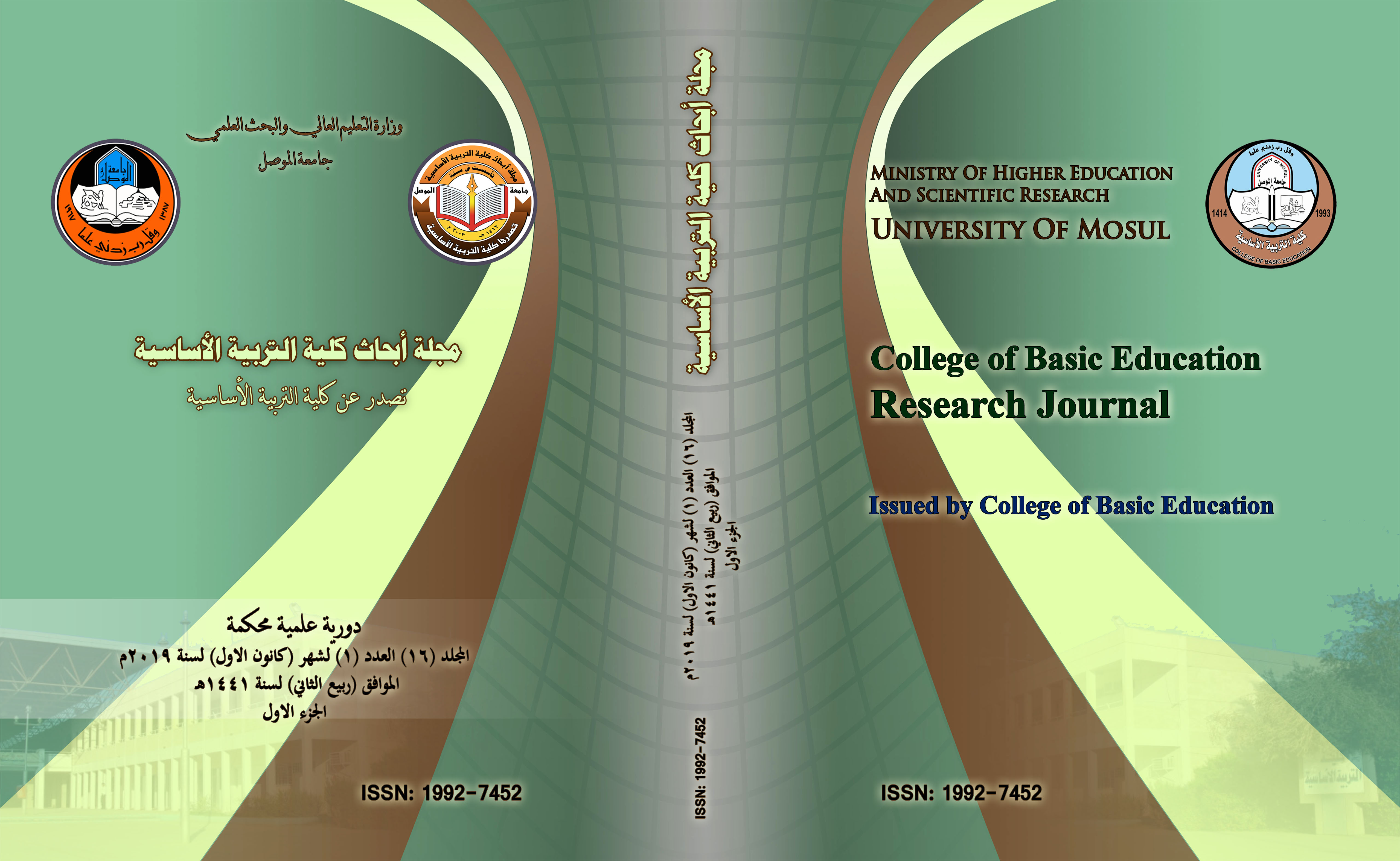Abstract
The current research aims to identify the impact of songs sung in the development of speaking skills in kindergarten children, and to achieve the goal of the research the researchers developed two hypotheses: -
1. There is no statistically significant difference at (0.05) between the average score of the children of the experimental group that was learned using songs and the average score of the children of the control group who were taught in the usual way in the distance test on the speaking skills test.
2. There is no statistically significant difference at (0.05) between the average score of the children of the experimental group and the average score of the children of the same group in the tribal and dimension tests of speaking skills.
The researchers used the experimental design with tribal and dimensional tests with the presence of a control group, where the experimental group learned according to the songs sung, and the control group learned according to the usual method, and the sample of the research reached (56) children and girls distributed by (28) children in the group Experimental, (28) children in the control group, the process of equalization of the two groups was conducted in the variables :(sex, age calculated in months, educational level of fathers and mothers, tribal test scores for speaking skills). The researcher prepared the necessary educational plans for both groups and number 9 plans for each group, and presented them to a committee of competent arbitrators to ascertain the validity of the educational plans. The researchers also developed a tool to measure speaking skills consisting of (29) images containing questions.
1. There is no statistically significant difference at (0.05) between the average score of the children of the experimental group that was learned using songs and the average score of the children of the control group who were taught in the usual way in the distance test on the speaking skills test.
2. There is no statistically significant difference at (0.05) between the average score of the children of the experimental group and the average score of the children of the same group in the tribal and dimension tests of speaking skills.
The researchers used the experimental design with tribal and dimensional tests with the presence of a control group, where the experimental group learned according to the songs sung, and the control group learned according to the usual method, and the sample of the research reached (56) children and girls distributed by (28) children in the group Experimental, (28) children in the control group, the process of equalization of the two groups was conducted in the variables :(sex, age calculated in months, educational level of fathers and mothers, tribal test scores for speaking skills). The researcher prepared the necessary educational plans for both groups and number 9 plans for each group, and presented them to a committee of competent arbitrators to ascertain the validity of the educational plans. The researchers also developed a tool to measure speaking skills consisting of (29) images containing questions.
Abstract
يهدف البحـــث الحالي التعرف على أثر الأناشيد المغناة في تنمية مهــــارات التحــدث لدى أطفال الروضــة، ولتحقيق هدف البحـــث وضع الباحثان فرضيتان وهي:
1. لا يوجد فرق ذو دلالـــة إحصائية عند مســــتوى (٠,٠٥) بين متوسط درجات أطفال المجموعة التجريبيــة التي تعلمت باستعمال الأناشيد المغناة وبين متوسط درجات أطفال المجموعة الضابطـــة التي تعلمت بالطريقة الاعتيادية في الاختبار البعدي على اختبار مهــــارات التحــدث.
2. لا يوجد فرق ذو دلالـــة إحصائية عند مســــتوى (0،05) بين متوسط درجات أطفال المجموعة التجريبيــة ومتوسط درجات أطفال المجموعة نفسها في الاختبارين القبلي والبعدي لمهــــارات التحــدث.
وقد استخدم الباحثان التصميم التجريبي ذو الاختبارين القبلي والبعدي مع وجود مجموعة ضابطة، إذ تعلمت المجموعة التجريبيــة وفقا للأناشيد المغناة، وتعلمت المجموعة الضابطـــة وفقا للطريقة الاعتيادية، وبلغت عينة البحـــث (56) طفلا وطفلة موزعين بواقع (28) طفلا وطفلة في المجموعة التجريبيــة، و(28) طفلا وطفلة في المجموعة الضابطـــة، وقد أجريت عملية تكافــؤ المجموعتين في متغيرات :(الجنس، العمر الزمني محسوبا بالأشهر، المســــتوى التعليمي للأباء والامهات، درجات الاختبار القبلي لمهــــارات التحــدث). وأعدت الباحثة الخطط التعليمية اللازمة لكلتا المجموعتين وعددها (9) خطط لكل مجموعة، وتم عرضها على لجنة من المحكمين من ذوي الاختصاص للتأكد من مدى صلاحية الخطط التعليمية. كما قام الباحثان بإعداد أداة لقياس مهــــارات التحــدث مكونة من (29) صورة تتضمن أسئلة.
1. لا يوجد فرق ذو دلالـــة إحصائية عند مســــتوى (٠,٠٥) بين متوسط درجات أطفال المجموعة التجريبيــة التي تعلمت باستعمال الأناشيد المغناة وبين متوسط درجات أطفال المجموعة الضابطـــة التي تعلمت بالطريقة الاعتيادية في الاختبار البعدي على اختبار مهــــارات التحــدث.
2. لا يوجد فرق ذو دلالـــة إحصائية عند مســــتوى (0،05) بين متوسط درجات أطفال المجموعة التجريبيــة ومتوسط درجات أطفال المجموعة نفسها في الاختبارين القبلي والبعدي لمهــــارات التحــدث.
وقد استخدم الباحثان التصميم التجريبي ذو الاختبارين القبلي والبعدي مع وجود مجموعة ضابطة، إذ تعلمت المجموعة التجريبيــة وفقا للأناشيد المغناة، وتعلمت المجموعة الضابطـــة وفقا للطريقة الاعتيادية، وبلغت عينة البحـــث (56) طفلا وطفلة موزعين بواقع (28) طفلا وطفلة في المجموعة التجريبيــة، و(28) طفلا وطفلة في المجموعة الضابطـــة، وقد أجريت عملية تكافــؤ المجموعتين في متغيرات :(الجنس، العمر الزمني محسوبا بالأشهر، المســــتوى التعليمي للأباء والامهات، درجات الاختبار القبلي لمهــــارات التحــدث). وأعدت الباحثة الخطط التعليمية اللازمة لكلتا المجموعتين وعددها (9) خطط لكل مجموعة، وتم عرضها على لجنة من المحكمين من ذوي الاختصاص للتأكد من مدى صلاحية الخطط التعليمية. كما قام الباحثان بإعداد أداة لقياس مهــــارات التحــدث مكونة من (29) صورة تتضمن أسئلة.
